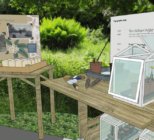To successfully understand what is relevant for different groups we need to empathise with them and the only way to do this well is to get to know these communities and listen to them, finding out what makes them feel welcome and what repels them.
At Tricolor we are passionate about museums and heritage sites working collaboratively with all kind of communities and have been supporting organisations through this process for seven years. Below are two case studies which provide an insight into how organisations are working with communities to build relevance.
Changemakers
Cornwall Museums Partnership and Royal Cornwall Museum
Dr Tehmina Goskar is a Changemaker working with Cornwall Museums Partnership and Royal Cornwall Museum as part of an Arts Council funded project examining how museums can work collaboratively with communities at leadership and governance levels.
Part of her work has helped create the ‘12 principles of collaborative leadership’, a list of practical and encouraging principles for heritage organisations that can see the value in working collaboratively. She believes that collaboration at a leadership level filters through to the way an institution understands its relevance for visitors and volunteers.
One project that has come out of this approach is ‘Citizen Curators’. Citizen Curators is a museum studies course in a work-based setting allowing volunteers to learn curatorial theory and practice without having to go on a full postgraduate course. The project enables volunteers to undertake essential training that is not always possible in rural communities.

Tricolor and Perfect Moment have been working alongside Dr Goskar at Royal Cornwall Museum on an HLF Resilience project relooking at the museum’s relationship with its audiences, marketing, business planning, interpretation and activity. Our approach has been co-productive one, influenced by the work undertaken by Goskar and the collaborative approach to community engagement she has encouraged at the museum.
Relevance in the case of Royal Cornwall Museum is being delivered through collaborative working, audience representation at all levels and a 360 degree approach to incremental planning.
The Canterbury Journey
Canterbury Cathedral
The Canterbury Journey is an ongoing large-scale project that seeks to engage new, young and hard to reach audiences by making the cathedral and its collections more accessible. The project included an 18 month consultation period which helped directly feed into the Cathedral’s Activity Plan and outreach strategy. Canterbury Cathedral used this consultation to understand and listen to the needs and wants of the local community, and now run a series of onsite and outreach programmes to meet these needs. Included in this is a new community pass, which means that more residents and other visitors have access to their local heritage for free.
Oyster Cathedral
One innovative partnership that formed as part of the Canterbury Journey project was with the Whitstable Oyster Festival. The project involved four fine art students from the University of the Creative Arts creating an 8-foot high wireframe model of the Cathedral, complete with stained glass windows. Festival-goers were invited to hang oyster shells onto the ‘wire cathedral’ and watch as, at nightfall, it was illuminated from inside by candles. The project helped to engage communities that would never normally visit the Cathedral, while also forming strong partnerships with other organisations.
Tricolor worked with Canterbury Cathedral to undertake the community consultation which underpinned the rest of the project. This included one-to-one interviews with stakeholders, focus groups with community representatives, outreach activities, and pilot sessions.
100 per cent success
Tricolor works with art, museum and heritage organisations of all shapes and sizes, supporting them in the creation of activity plans, audience development plan, interpretation strategies and design, business plans and HLF applications. We have a 100 per cent success rate for Heritage Lottery Fund Round 1 applications and we understand the challenges faced by heritage organisations as well the complex requirements of funders.
If your organisation would like to be more relevant, we are offering a free planning session to readers using the code MHRELEVANT, through our website: http://tricolorassociates.co.uk/contact-us/.
To find out more about Tricolor and the work we do, follow us on Twitter @TricolorHeritag and Facebook – @TricolorAssociates











